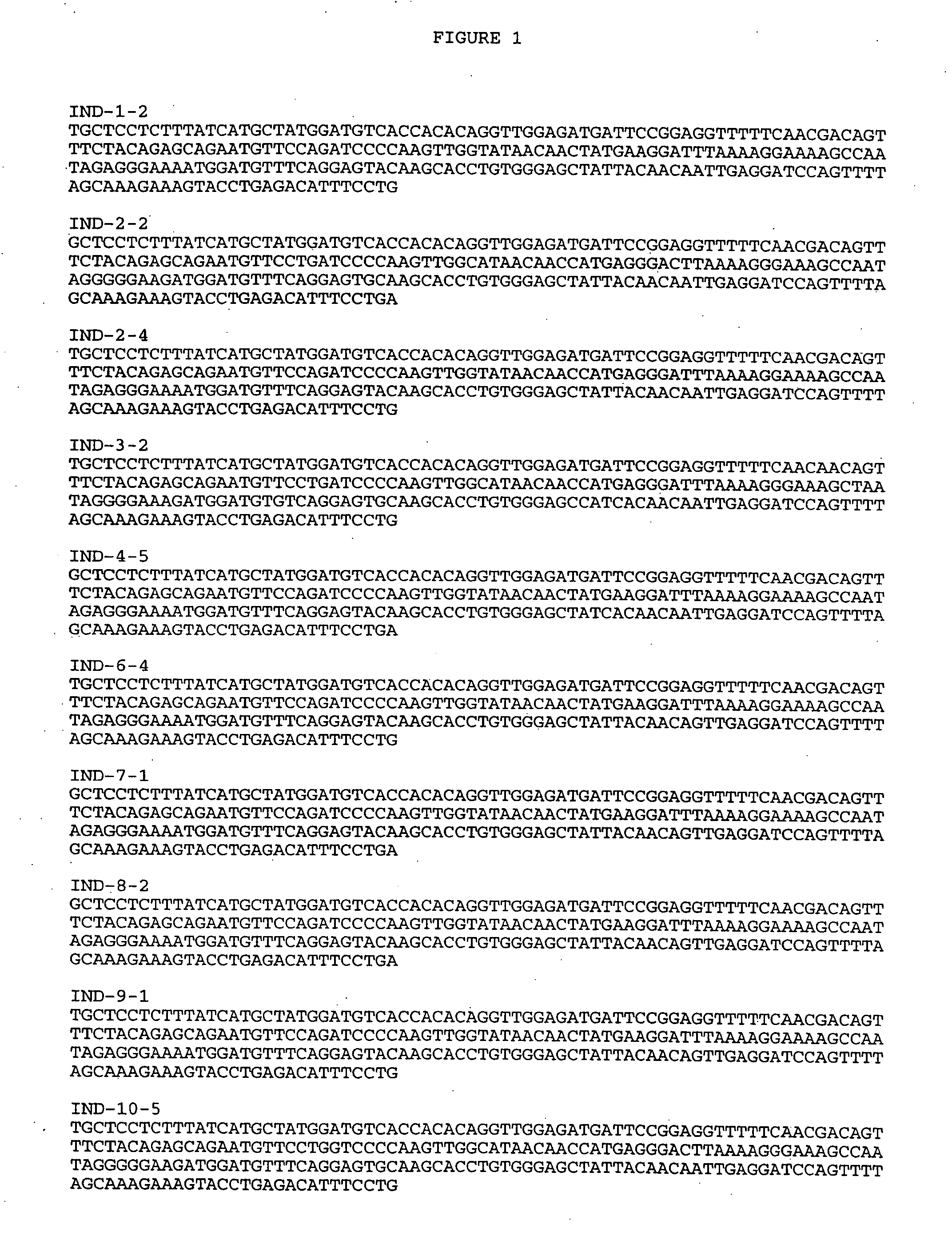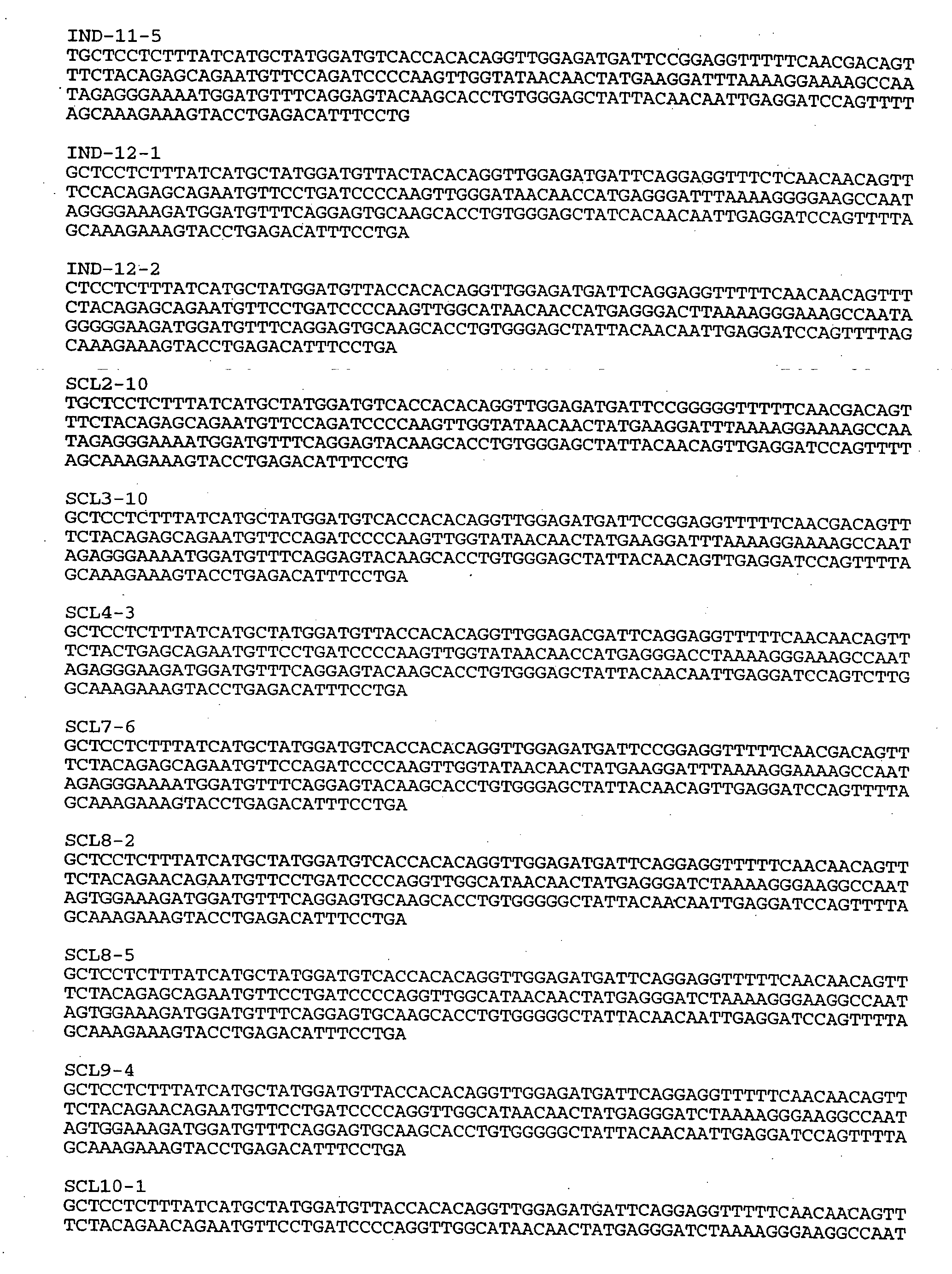Hepatitis a virus nucleotide sequences, recombinant proteins and uses thereof
a technology of hepatitis a virus and nucleotide sequences, applied in the field of viral diagnostics, can solve the problems of low yield of virus, difficult direct manipulation of viral genome, and poor growth of virus in cell cultur
- Summary
- Abstract
- Description
- Claims
- Application Information
AI Technical Summary
Problems solved by technology
Method used
Image
Examples
example 1
Hepatitis A Nucleic Acid Extraction for RT-PCR
[0147] Human serum samples that had previously tested positive for HAV by IgM anti-HAV ELISA [ETI-HA-IgMK PLUS; DiaSorin, Inc; Saluggia (VC), Italy] were used to isolate RNA for subsequent experiments. Samples were stored at −80° C. until used. RNA was extracted from 0.14 mL of serum using the QIAamp Viral Mini Spin Kit (QIAGEN, Valencia, Calif.) following the manufacturer's specifications.
example 2
Detection of Hepatitis A Nucleic Acid-Positive Samples by RT-PCR
[0148] The RT-PCR was performed using the Titan One Tube RT-PCR Kit (Roche, Mannheim, Germany) to amplify a 243 bp fragment in the VP3 / VP1 region. The 243 bp fragment corresponds to nucleotide positions 2172-2415 of the HAV genome as reported by Cohen et al. (1987) J. Virol. 61: 50-59.
[0149] Experiments were performed using the primers shown in Table 1 and the procedures described below.
TABLE 1Primers used in the “RT-PCR” ExperimentsSEQPCRGenomicIDPrimerSequenceproductregionNO:SN2172GCTCCTCTTTATCATGCTATGGAT243 bpVP3 / VP149SN2415GAGGAAATGTCTCAGGTACTITGT243 bpVP3 / VP150
For this experiment, the “RT-PCR” was performed in a final volume of 50 μL using 10 μL of extracted HAV RNA following the manufacturer's specifications. The amplification profile involved reverse transcription at 50° C. for 30 min., template denaturation at 94° C. for 2 min., denaturation at 94° C. for 30 sec., primer annealing at 55 ° C. for 30 sec. and...
example 3
Cloning of Hepatitis A Fragments
[0151] The PCR fragments were cloned into TOPO-TA vectors (Invitrogen, Carlsbad, Calif.). Cloning into these vectors is highly facilitated when the amplified DNA contains a single deoxyadenosine (A) at its 3′ end. Accordingly, a catalytic reaction to add the 3′ (A) overhead was used. The reaction mix contained 1.25 mM of dATP, 0.5 units of Taq polymerase (Perkin Elmer, Boston, Mass.) and proceeded at 72 C for 15 min.
[0152] PCR fragments were cloned into the pCR2.1-TOPO vector using the Invitrogen's TA cloning kit (TOPOTM TA CloningR Kit with One Shot TOP10 Electrocompetent Cells) following the manufacturer's specifications. Bacterial cells were incubated at 37° C. on Luria Broth plates containing ampicillin at 100 μg / mL, 0.66 mM IPTG and 0.033% X-Gal. A number of white colonies were inoculated in 4 mL of Luria-Broth ampicillin (100 μg / ml) and incubated overnight at 37° C. with shaking. Three mL of the overnight cultures were used to prepare plasmid ...
PUM
| Property | Measurement | Unit |
|---|---|---|
| temperatures | aaaaa | aaaaa |
| temperatures | aaaaa | aaaaa |
| temperatures | aaaaa | aaaaa |
Abstract
Description
Claims
Application Information
 Login to view more
Login to view more - R&D Engineer
- R&D Manager
- IP Professional
- Industry Leading Data Capabilities
- Powerful AI technology
- Patent DNA Extraction
Browse by: Latest US Patents, China's latest patents, Technical Efficacy Thesaurus, Application Domain, Technology Topic.
© 2024 PatSnap. All rights reserved.Legal|Privacy policy|Modern Slavery Act Transparency Statement|Sitemap



